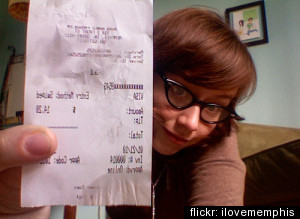 As lawmakers and health experts wrestle over whether a controversial chemical, bisphenol-A, should be banned from food and beverage containers, a new analysis by an environmental group suggests Americans are being exposed to BPA through another, surprising route: paper receipts.
As lawmakers and health experts wrestle over whether a controversial chemical, bisphenol-A, should be banned from food and beverage containers, a new analysis by an environmental group suggests Americans are being exposed to BPA through another, surprising route: paper receipts.
The Environmental Working Group found BPA on 40 percent of the receipts it collected from supermarkets, automated teller machines, gas stations and chain stores. In some cases, the total amount of BPA on the receipt was 1,000 times the amount found in the epoxy lining of a can of food, another controversial use of the chemical.
Sonya Lunder, a senior analyst with the environmental group, says BPA's prevalence on receipts could help explain why the chemical can be detected in the urine of an estimated 93 percent of Americans, according to the Centers for Disease Control and Prevention.
"We've come across potentially major sources of BPA right here in our daily lives," Lunder said. "When you're carrying around a receipt in your wallet for months while you intend to return something, you could be shedding BPA into your home, into your environment. If you throw a receipt into a bag of food, and it's lying there against an apple, or you shove a receipt into your bag next to a baby pacifier, you could be getting all kinds of exposure and not realize it."
What remains unknown is how much of the chemical that may rub off onto the hands is absorbed through the skin or whether people then ingest BPA by handling food or touching their mouths.
Among those surveyed, receipts from Safeway supermarkets contained the highest concentration of BPA. A receipt taken from a store in the District contained 41 milligrams of the chemical. If the equivalent amount of BPA was ingested by a 155-pound adult, that would exceed EPA's decades-old safe exposure limit for BPA by 12 times.





 The US supreme court on Monday heard arguments in a case that could threaten Americans’ access...
The US supreme court on Monday heard arguments in a case that could threaten Americans’ access... Toothpaste can be widely contaminated with lead and other dangerous heavy metals, new research shows.
Most of...
Toothpaste can be widely contaminated with lead and other dangerous heavy metals, new research shows.
Most of...






























